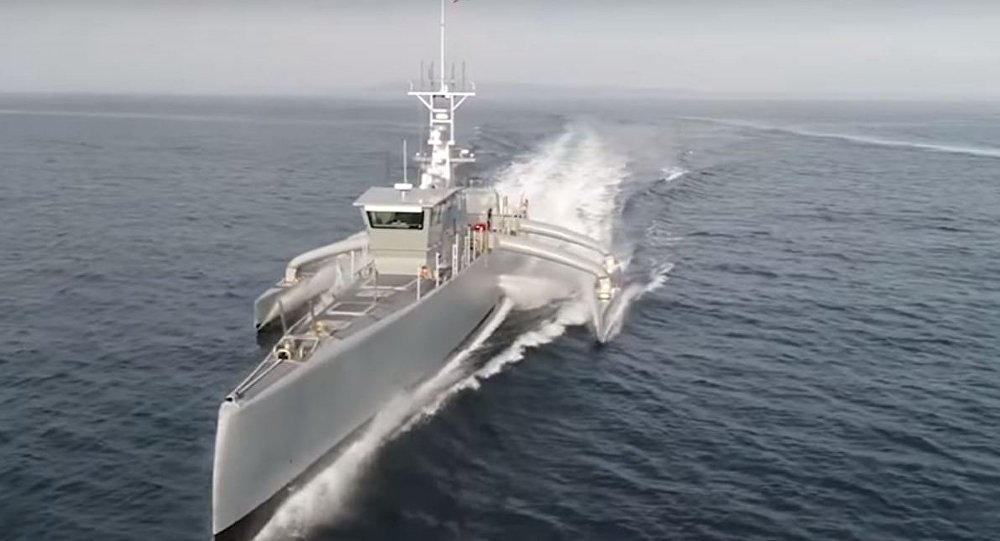
The medium displacement unmanned surface vehicle (MDUSV) prototype SEA HUNTER is moored at Joint Base Pearl Harbor-Hickam, Hawaii. Autonomous USVs like SEA HUNTER are creating a new paradigm for Navy surface forces, as they are capable of carrying a variety of pay- loads and performing many missions, including operations independent of manned Navy ships.
Unmanned ASW platforms are not con- fined to underwater. With the development of artificial intelligence and secure wireless communications systems, autonomous surface vessels have become feasible. The US Navy is currently testing the SEA HUNTER, a prototype medium displacement unmanned surface vehicle (MDUSV). Initially developed by DARPA, the project transitioned to the Office of Naval Research in January 2018 for further development and was recently designated a classified programme. The 135-tonne USV is capable of littoral and high seas operations, with an intended range of 10,000 nautical miles and at sea endurance of 30-90 days. The vessel can carry various payloads, including an ASW suite. Originally designated the Anti-Submarine Warfare Continuous Trail Unmanned Vessel (ACTUV) by DARPA, the unarmed USV uses hull-mounted sonar and an on-board sensor data processing suite to detect and identify diesel-electric submarines. It can track submerged targets for weeks, until they surface or return to port. If the target is classified as a threat, the USV can transmit target coordinates to manned ships or aircraft.
“It is the ability of the Sea Hunter sensors to sense other vessels that might be in the way and then for Sea Hunter to react appropriately and maneuver appropriately around those other vessels in accordance with the ColRegs,” said Dr. Robert Brizzolara, Medium- Displacement Unmanned Surface Vehicle program director at the Office of Naval Research.
Under the Anti-Submarine Continuous Trail Unmanned Vehicle program, Sea Hunter originally was planned as a USV that would independently trail diesel subma- rines. However, the Office of Naval Research plans first to begin testing a mine-countermeasures payload on the Sea Hunter this summer. An advanced EO/IR sensor will be fit- ted in the fall. In fiscal 2018, an ISR payload is scheduled, to be followed in 2019 by an ASW payload.
The Sea Hunter is equipped with three radars. Brizzolara said it even- tually will be fitted with a stereo camera – developed by Office of Naval Research’s “Swamp Works” – that will allow it to determine distance visually to a contact or shoreline. The stereo camera will supplement a monocular camera.
Automatic target recognition also is being developed for the EO/IR systems.
“For example, we are developing capability where a radar contact bearing will be used to point the very narrow field of view monocular EO camera at the other vessel to get an image of that and then run that image through an automated target recognition algorithm and then come out with a general type of vessel that that other vessel is: a tanker, a sailboat, that sort of thing,” he said.
The Office of Naval Research “and the Navy are really looking at this platform as a multimission platform and it does have the ability to accept many different payloads for different missions,” Brizzolara said. “We’ve chosen MCM, ISR and ASW as examples to demonstrate out on the water of what Sea Hunter can do and what can be integrated on Sea Hunter, but I think that the variety of payloads, in addition to those three in the future, is potentially very large. We are actively working and talking with other commands about other payloads that could be integrated in the future.”
Brizzolara said a rail system is being installed on the aft deck of Sea Hunter with standardized lock- downs for payloads.
He said, “there are still significant [science and technology] challenges that remain to be solved in terms of the technology development. Primary among those is continued development of the autonomous control of the vessel. The other part of it, though, is as we integrate these payloads, there is an implication of a particular payload to the autonomous control in that we have to implement mission-specific tactics in the autonomy for many of these payloads.
“ASW is a great example,” Brizzolara said. “The platform might have to search a defined area for a while. And then, if it gets a contact, it might have to go investigate that contact. And then, it might have to go into track mode and then trail mode. Each of those we call a behavior within autonomy and the vessel needs to be able to do those things by itself and it needs to be able to switch between those at the appropriate time, based on cues that it gets from its sensors.”
DISPLACEMENT: . . . . . . . . . 140 tons
LENGTH: . . . . . . . . . . . . . . . . 132 feet
SPEED: . . . . . . . . . . . . . . . . . . 27 knots
CONTRACTORS: . . . . . . . . . Leidos, Vigor